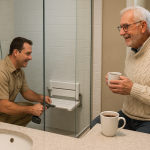Staying Active Doesn’t Mean Doing It Alone
When it comes to staying active as we age in place, having the right support makes all the difference. That’s why I often talk about rollators to my senior friends who are looking for reliable walking aids. With four wheels, hand brakes, and a built-in seat, rollator walkers offer more support and freedom than standard walkers—helping you stay independent.
“The best rollator for you isn’t necessarily the fanciest one—it’s the one that fits your body, your space, and your lifestyle.”
Another often overlooked bonus is the fact they can be outfitted with some of the same wheelchair accessories you’ve grown accustomed to. As a member of the senior demographic, I’ve seen firsthand how rollators can transform daily life. In this guide, I’ll walk you through everything you need to know about rollator walkers, for yourself or a loved one.
What are Rollators and Why Might You Need One?
Rollators are essentially upgraded walkers with wheels that provide support while offering more flexibility and features than traditional walkers. Many seniors prefer rollator walkers because they don’t require lifting with each step, making them perfect for those with limited arm strength or those who tire easily.
The key features that make rollators stand out include:
- Three or four wheels for smooth, continuous movement
- Hand brakes for safety and control
- A built-in seat for resting when needed
- Storage space like baskets or pouches for personal items
- Adjustable height handles for personalized comfort
Rollators vs. Standard Walkers: Which Is Right for You?
“The strongest feedback I’ve heard is that seniors appreciate how rollator walkers allow them to maintain a more natural walking motion. Rather than the stop-and-go pattern of a standard walker, rollator walkers flow and pivot with your natural movement.”
When the topic of mobility options comes up with other seniors, I always point out the key differences between rollators and standard walkers. Here’s how they compare:
Benefits of Rollator Walkers
- Smoother movement without lifting
- Built-in seat provides a place to rest
- Storage space for personal items and essentials
- Better suited for outdoor use and longer outings
- Promotes more independence and a natural gait
Benefits of a Standard Walker
- Provides more stability for those with balance issues
- Lighter weight and easier to transport
- Better for navigating very narrow spaces
- Often less expensive
In my experience, rollator walkers are typically best for seniors who:
- Can walk but need some additional support
- Get tired easily and benefit from having a place to sit
- Want to maintain an active lifestyle with longer outings
- Have decent balance but need assistance
- Have limited arm strength for lifting a standard walker
Types of Rollator Walkers to Consider
Over the years, I’ve learned that different designs serve different purposes, and understanding the types will help you make the right choice.
3-Wheel Rollator Walkers
These feature a triangular frame with one wheel in front and two in back. I often refer to these for indoor use and navigating tight spaces.
Advantages:
- Lighter weight than 4-wheel models
- Better maneuverability in tight spaces
- Easier to navigate through narrow doorways
- More compact when folded
Disadvantages:
- Less stable than four-wheel models
- Usually don’t include a seat
- May not handle outdoor terrain as well
4-Wheel Rollators
This is the most common type I recommend. 4-wheel rollator walkers offers excellent stability and includes a seat, making it versatile for many seniors.
Advantages:
- Maximum stability for confident walking
- Comfortable seat for rest breaks
- Better for outdoor use and longer walks
- More storage options for personal items
Disadvantages:
- Heavier than 3-wheel models
- Takes up more space
- Can be harder to maneuver in tight spots
Bariatric Rollators
For larger individuals or those needing additional durability, I suggest considering a bariatric rollator walker.
Advantages:
- Higher weight capacity (up to 500 lbs)
- Wider seat and frame for comfort
- Extra stability and durability
Disadvantages:
- Heavier and bulkier
- May not fit through standard doorways
All-Terrain Rollators
These are well suited to seniors who enjoy spending time outdoors. With special wheels and suspension systems, they’re built for adventure.
Advantages:
- Larger wheels for better grip on uneven surfaces
- Shock absorption for comfort on rough terrain
- Handles uneven surfaces like grass, gravel, or park paths
Disadvantages:
- Bulkier and heavier than standard models
- More expensive
Here’s a quick overview of the different types of rollator walkers and how they match different needs:
Types of Rollator Walkers at a Glance
| Type | Best For | Key Advantage | Key Trade-Off |
|---|---|---|---|
| 3-Wheel | Indoor use, tight spaces | Lightweight, agile | Less stable, no seat |
| 4-Wheel | General daily use | Stable, comfortable seat | Heavier, wider |
| Bariatric | Higher weight support | Durable, sturdy | Heaviest, bulkier |
| All-Terrain | Outdoor, rough surfaces | Larger wheels, shock absorption | Bulkier, more expensive |
📌 Use this quick chart to match the right rollator to your lifestyle and needs.
Now that you have a sense of the different types, let’s take a closer look at what features matter most when choosing a rollator
Important Features to Consider in Rollator Walkers
When asked about the rollator walker, I always emphasize these key features:
Wheel Size and Type
- Small wheels (6″): These are best suited to smooth indoor floors and even surfaces
- Large wheels (8-10″): Better for rough outdoor terrain and uneven surfaces
- Some premium models offer air-filled tires for maximum comfort and shock absorption
Seat and Backrest
I can’t stress enough how important a comfortable seat is for many seniors. Look for:
- Padded seat for comfort during rest breaks
- Adjustable seat height if possible
- Supportive backrest that provides stability when sitting
- Seat width that fits the user comfortably
Weight and Portability
If you’ll be transporting your rollator walker often, consider:
- Lightweight models are easier to lift into a car
- Foldable designs take up less space for storage or transport
- Some models now offer one-hand folding mechanisms
Braking System for Rollators
Based on my experience, the braking system is a crucial safety feature:
- Loop brakes: Squeeze to stop; can be locked for sitting
- Push-down brakes: Engage with downward pressure; ideal for those with limited hand strength
- Always test the brakes to ensure they feel comfortable and secure
Height Adjustability
For proper posture and comfort, I always ensure:
- Handles should be at wrist level when standing upright
- Elbows should bend slightly (about 20-30 degrees) when gripping
- Easy tool-free adjustment is ideal for making changes as needed
Storage and Accessories
Similar to wheelchair accessories, I’ve found these popular add-ons enhance the convenience of a rollator walker:
- Baskets or bags for carrying personal items
- Cup holders for staying hydrated on outings
- Cane or oxygen tank holders for those with additional needs
- LED lights or phone holders for modern convenience
When comparing rollator walkers, these key features can make a big difference in daily comfort and confidence:
Key Features to Consider When Choosing a Rollator
| Feature | Why It Matters | Tip |
|---|---|---|
| Wheel Size | Indoor vs outdoor performance | 6″ indoor, 8–10″ outdoor |
| Seat Comfort | Resting during outings | Look for padding + backrest |
| Weight | Ease of transport | Under 20 lbs = easier lifting |
| Brakes | Safety and stability | Test loop vs push-down brakes |
| Height Adjustability | Proper walking posture | Handles at wrist height, slight elbow bend |
📌 These key features can make daily use easier, safer, and more comfortable.
Keeping these features in mind can help you find a rollator that feels natural, safe, and comfortable to use every day.
How to Use Rollator Walkers Safely
“I suggest testing your rollator walker indoors first—especially the brakes and turning radius. Get a feel for how it handles in your own space before venturing outdoors. Practice using the brakes on a smooth indoor floor until engaging them becomes second nature. Think of it like adjusting to a new pair of shoes—get familiar with what to expect before going on a long walk.”
Safety is a top priority for using rollators. Here are my tried-and-true tips:
Proper Adjustment
- Set handles to wrist height when standing tall
- Ensure seat height allows feet to comfortably touch the floor
- Check all parts and connections before each use
Walking Technique
- Stand upright with good posture, hands resting on the handles
- Keep the rollator walker close to your body (not pushed far ahead)
- Walk into the rollator, not behind it
- Look forward, not down at your feet
- Take normal-sized steps at a comfortable pace
Sitting and Standing
- Always lock the brakes before sitting down
- Back up until you feel the seat against the back of your legs
- Use the handles to lower yourself slowly onto the seat
- To stand, push up from the seat using the handles for support
Using Brakes Effectively
- Squeeze gently to slow down on inclines
- Always lock brakes before sitting
- Check brake function regularly
- Practice using brakes in a safe environment first
“Before heading outdoors, get comfortable with your rollator — like breaking in a good pair of shoes.”
Who can Benefit Most from a Rollator?
In my experience, I’ve found that rollator walkers may be right for those:
- Seniors that need more support than a cane but less than a wheelchair
- Users who get tired easily and need to rest during walks
- Seniors that have decent balance but want added security
- That are mobile but struggle to lift a standard walker
- Seniors wanting to maintain an active lifestyle with longer outings
You might prefer a standard walker if:
- You have very limited balance
- You need maximum stability
- You need to put significant weight on the walker frame
Comparison: Rollators vs Standard Walker
Quick Glance: Here’s how rollators stack up against standard walkers:
Quick Comparison: Rollators vs Standard Walkers
| Feature | Rollator Walker | Standard Walker |
|---|---|---|
| Wheels | Yes (3 or 4 wheels) | No (or front wheels only) |
| Seat | Yes | No |
| Brakes | Yes | No |
| Weight | Heavier (13–25 lbs) | Lighter (6–8 lbs) |
| Stability | Moderate | High |
| Indoor Use | Good | Excellent |
📌 Use this quick comparison to help choose the right walker for your needs.
Routine Care = Longer Lasting Support
Maintaining Rollator Walkers
I always emphasize preventive maintenance. Well-maintained rollators last longer and stay safer.
Routine Checks
- Test brakes before each use
- Tighten loose bolts or screws monthly
- Check for damage or wear regularly
- Ensure wheels spin freely
Cleaning
- Wipe down the frame regularly with a damp cloth
- Use mild soap on tough dirt or stains
- Keep it dry to prevent rust or corrosion
- Pay special attention to wheels that can collect debris
Lubrication
- Lubricate brakes and folding joints every few months
- Use silicone-based spray (avoid WD-40 which can attract dirt)
- Apply to moving parts as needed
Insurance Coverage for Rollator Walkers
Medicare may cover a rollator walker if:
- You have a doctor’s prescription
- The rollator is deemed medically necessary
- You complete a face-to-face mobility exam
- You purchase from a Medicare-approved supplier
Other payment options I would suggest exploring:
- Medicaid coverage (varies by state)
- VA benefits for veterans
- Private insurance (check your policy details)
- Community nonprofits or medical equipment loan closets
Finding the Right Fit for You
“Even rollator wheels can quietly track dust and allergens from outside to inside—especially if you use yours for both indoor support and outdoor walks. For simple ways to improve indoor air, check out my how-to allergy proof your home guide for seniors aging in place.”
A rollator walker can truly be a life-changing mobility aid. I’ve seen how the right rollator walker gives seniors greater independence, safety, and peace of mind. By understanding the different types and features, you can make a smart choice that matches your lifestyle and physical needs.
Final Thoughts
Try out different model rollators if possible. Talk with your doctor about specific mobility concerns and how they might affect comfort and function. With the right rollator walker, you or your loved one can stay mobile, active, and confident—every step of the way.
“The right support doesn’t just keep you steady — it keeps you moving toward everything that matters most.”
Remember that staying active doesn’t mean doing it alone. A rollator walker provides just the right amount of support while helping maintain the independence that’s so important to all of us as we age in place.






